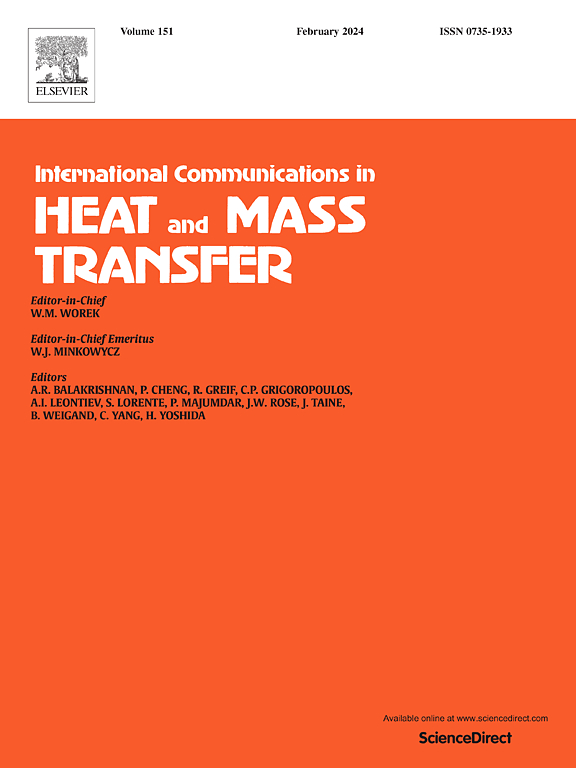Dynamic wetting behavior of soluble surfactant-laden droplets under shear: A phase field based lattice Boltzmann method
IF 6.4
2区 工程技术
Q1 MECHANICS
International Communications in Heat and Mass Transfer
Pub Date : 2025-07-17
DOI:10.1016/j.icheatmasstransfer.2025.109358
引用次数: 0
Abstract
Surfactants can reduce the surface tension of fluid interface and significantly change the wetting characteristics, demonstrating versatility in droplet manipulations. In this work, a phase field based lattice Boltzmann method (PF-LBM) is employed to investigate the dynamics behavior of soluble surfactant-laden droplets on solid surfaces subjected to a linear shear flow. We propose to extend the Yokoi dynamic contact angle model to the scenarios containing surfactant effects. Comparisons between the Yokoi model with the Young equation-based model demonstrate that the dynamic contact angle predicted by the Young equation-based model remains constant on the neutral surface. It implies that the Young equation-based model has limitations in accurately describing the dynamics behavior of droplet with soluble surfactant. By contrast, the Yokoi model reproduces more reasonable dynamic variation of contact angle, demonstrating good universality and reliability. Furthermore, we employ the Yokoi model to further investigate the shearing behavior of soluble surfactant-laden droplets, focusing on the influence of surfactant concentration on droplet deformation and identifying the critical conditions for droplet rupture. The results reveal that for a certain effective capillary number (Cae), there exists a critical surfactant concentration, beyond which the droplet rupture occurs. Moreover, the critical surfactant concentration for droplet rupture decreases monotonically with increasing Cae.
剪切作用下可溶表面活性剂液滴的动态润湿行为:基于相场的晶格玻尔兹曼方法
表面活性剂可以降低流体界面表面张力,显著改变液滴润湿特性,显示了液滴操作的多功能性。在这项工作中,采用基于相场的晶格玻尔兹曼方法(bf - lbm)研究了固体表面上受线性剪切流动影响的可溶性表面活性剂液滴的动力学行为。我们建议将Yokoi动态接触角模型扩展到含有表面活性剂效应的场景。Yokoi模型与Young方程模型的比较表明,Young方程模型预测的动态接触角在中性表面上保持恒定。这表明基于Young方程的模型在准确描述液滴与可溶性表面活性剂的动力学行为方面存在局限性。相比之下,Yokoi模型更合理地再现了接触角的动态变化,具有较好的通用性和可靠性。此外,我们采用Yokoi模型进一步研究了可溶表面活性剂负载液滴的剪切行为,重点研究了表面活性剂浓度对液滴变形的影响,并确定了液滴破裂的临界条件。结果表明,对于一定的有效毛细数(Cae),存在一个临界表面活性剂浓度,超过该浓度,液滴就会破裂。随着Cae的增加,液滴破裂的临界表面活性剂浓度单调降低。
本文章由计算机程序翻译,如有差异,请以英文原文为准。
求助全文
约1分钟内获得全文
求助全文
来源期刊
CiteScore
11.00
自引率
10.00%
发文量
648
审稿时长
32 days
期刊介绍:
International Communications in Heat and Mass Transfer serves as a world forum for the rapid dissemination of new ideas, new measurement techniques, preliminary findings of ongoing investigations, discussions, and criticisms in the field of heat and mass transfer. Two types of manuscript will be considered for publication: communications (short reports of new work or discussions of work which has already been published) and summaries (abstracts of reports, theses or manuscripts which are too long for publication in full). Together with its companion publication, International Journal of Heat and Mass Transfer, with which it shares the same Board of Editors, this journal is read by research workers and engineers throughout the world.

 求助内容:
求助内容: 应助结果提醒方式:
应助结果提醒方式:


